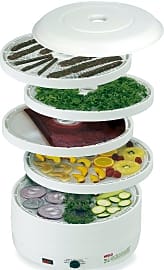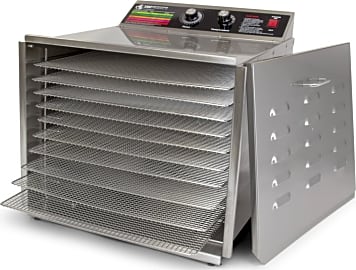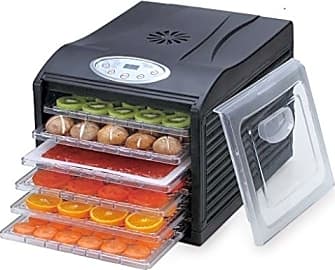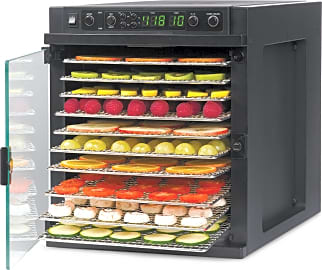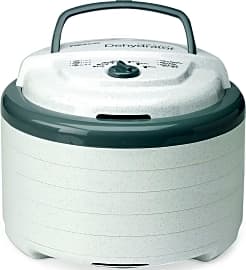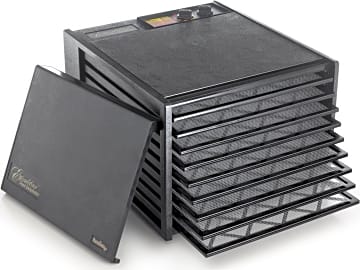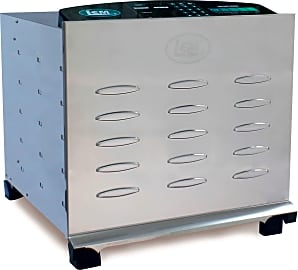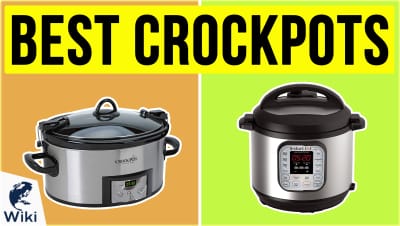The 10 Best Dehydrators

This wiki has been updated 40 times since it was first published in May of 2015. Whether you're trying to preserve foods for extended periods of time or are looking for a healthy alternative to snacking on chips and candy, one of these dehydrators can help. Our selections offer multiple drying trays and adjustable thermostats with a range of temperature settings that make it easy to prepare a variety of tasty treats, from fruits and vegetables to beef jerky. When users buy our independently chosen editorial picks, we may earn commissions to help fund the Wiki.
Editor's Notes
November 25, 2020:
During this round of updates, while the L’Equip FilterPro and Gourmia GFD1650 were both removed due to availability issues, the NutriChef PKFD12 was replaced by the NutriChef NCDH4S.5. We felt that the NCDH4S.5 had a slicker interface and we preferred its style of housing, but it should be noted that its maximum temperature is only 158 Fahrenheit, compared to the PKFD12’s 180 Fahrenheit. While NutriChef still advertises the NCDH4S.5 as simple means of producing beef jerky, it should also be noted that the USDA recommends that meat be dried at 160 Fahrenheit, and poultry at 165 Fahrenheit, which the NCDH4S.5 falls just short of.
We also decided on sticking with the Excalibur 3926TB, in lieu of switching it out for the Excalibur 3900B, which the company was presenting as a newer model at the time of this update. The basis for this decision was simple: As far as we can tell, the only difference between the 3926TB and the 3900B is that the latter lacks a timing apparatus, even though it’s priced slightly higher than the former, which gave us no real reason to upset our existing ranking for Excalibur.
Our new additions this time around are the LEM 1154 and VVINRC Commercial Professional — two industrial-style offerings with stainless steel housings. The LEM 1154 caught our eye with its 16 square feet of drying space – which is more than any unit we ranked, although stackable options like the Nesco FD-1018A Gardenmaster could potentially exceed it with the inclusion of add-on trays – but one problem that it presents is that it has no convenient means of observing your food as it dehydrates. The VVINRC Commercial Professional, by contrast, has a slightly smaller capacity of around 14 square feet, but really sets itself apart from the 1154 with a large window on its front door, which takes some of the guesswork out of deciding when to check on your food.
While we kept this list focused on appliances strictly dedicated to dehydrating, there’s been a new wave of multifunctional air fryers gaining popularity on the market that, among a host of additional useful features, work as serviceable dehydrators. So, before you buy, at the risk of severely complicating your purchase decision, I’d like to recommend that you check out our list of Best Air Fryers. You might find something you really like.
December 12, 2019:
Dehydrating can be a fun, tasty, and healthy hobby, and to do it right you'll need a relatively specialized piece of equipment. Because we're not slow-cooking here, none of these get very hot, and the differences start to show in not just capacity but also ease of use and consistency of results. If you're new to the game and not sure if drying food is really your favorite hobby yet, the NutriChef PKFD12 and Nesco Snackmaster Pro are two affordable options that do a decent job, though you'll want to check their progress pretty frequently and you might have to switch the trays around repeatedly to get an even dryness across the entire batch.
But the kicker is, you don't have to spend a fortune by any means to get a quality unit for home use. The L'Equip FilterPro, for instance, is a good mid-range option that lets you stack up to 15 layers of produce, although it doesn't work as quickly as some others. The Nesco FD-1018A Gardenmaster comes with eight trays and lets you use up to 30 at once, giving it the highest capacity in its price range. But not only can it handle bulk processing, it actually comes out on top in a number of effective real-world tests. The Samson Silent is another well-performing option, and in fact is just about as good of a horizontal-flow dehydrator as you'll find.
If you'll be using it frequently -- for example, in a restaurant or commissary -- You might want to make a larger investment. The Excalibur 3926TB has removable metal mesh trays that are easier to clean than many plastic ones and the Magic Mill Commercial Pro has enough heating and fan power to satisfy professional chefs, though it does come at a high cost. Even more expensive is the Tribest Sedona Express, but it's also one of the hottest and has quite the large capacity. And while you'll find it sold with several different brand names attached to it, the TSM Products 32706 is an old standby in many high-volume restaurants, thanks in part to its simple, stainless-steel design. And if you do try your hand at dehydrated meats or vegetables and you feel like they're just missing that certain something, check out our selection of electric smokers, a few of which are perfect for imparting woody, complex flavors over long periods of time. Also, to properly prepare your food for drying, you'll need either a good chef's knife or a quality mandoline slicer to get the pieces the right size.
Raw Power
If you've spent any time looking into ways to easily improve your health and wellness through your diet, you've probably heard of raw nutrition.
If you've spent any time looking into ways to easily improve your health and wellness through your diet, you've probably heard of raw nutrition. The raw foods movement has gained some pretty major traction over the past couple of decades, bolstered by a huge uptick in smoothie and juice sales, and by an association between these drinks and certain significantly attractive celebrities.
Whatever your reasons for investigating food dehydrators, it's important to know how they work, as well as what raw foods actually offer you. Otherwise, you might just dehydrate and eat an absurd amount of blueberries and end up diabetic.
With raw foods, it's all about the enzymes. Live enzymes in food aid in digestion, fight the oxidation of your cells (the thing that causes aging), have been shown to improve stamina and virility, and generally make you feel good. As soon as any natural food undergoes processes like extreme pressurization or, more commonly, cooking above 104 degrees Fahrenheit, those enzymes begin to die off.
Exposure to oxygen will also cause a loss of enzyme activity, which you can actually see happening if you cut open an apple and watch as it turns brown before your eyes.
While a food dehydrator doesn't cook your foods, per se, it does employ a low level of convection heating, usually around 98˚F, to slowly cause the foods inside to dry up. Put a handful of sliced tomatoes in your dehydrator overnight, and you'll have sundried tomatoes (the raw kind) in the morning. Throw a few slices of salted mango in there while you're at work, and when you get home, you'll have your very own vegan jerky.
The recipes are nearly endless, as anything that has moisture can undergo a transformation in your dehydrator. Some foods are better left alone, I've found, but the vast majority of them become something altogether compelling after half a day under the gentle heat. Take note of these cooking times, however, as the process is a process, and it takes time to dehydrate your foods completely.
Undercooked To Perfection
Not everybody is going to keep to a raw food diet. Even raw foodists most often practice what they call "80/20 raw," which means that roughly 80 percent of their diet consists of raw foods, and the rest can be cooked. This is a much more sustainable method, especially on those cold winter evenings when a hot bowl of soup is the only thing standing between you and succumbing to one of those awful winter flu bugs.
Whatever capacity you find attractive for your dehydrating purposes, it's important to note that all of these dehydrators take up a good deal of space in the kitchen.
What's great about these dehydrators is that they aren't all exclusively designed for the raw foods crowd, as some of them get hot enough to perform dehydrating functions in much less time and without the danger of burning you get from using a conventional convection oven.
If you're interested in picking up a dehydrator more for the long term savings you'll see compared to buying pre-dried fruits and vegetables, or simply for the fun of it, you might want to look at our list for a model that can comfortably break that 104-degree Fahrenheit raw foods threshold. This is especially useful if you want to dehydrate anything like fish or meat into jerky that really ought to meet temperatures at or above 140 degrees Fahrenheit to ensure the elimination of potentially harmful bacteria.
For the purists among you, whether or not your dehydrator goes above this threshold is immaterial. Your considerations are those of anyone else in the market, however. You'll want to ask yourself how much dehydrating you actually plan to do, and what capacity dehydrator you'll need to do it.
Whatever capacity you find attractive for your dehydrating purposes, it's important to note that all of these dehydrators take up a good deal of space in the kitchen. Since the process takes so long, and since it's so easy to plow through all the delicious treats you can make, it'll behoove you to keep this thing somewhere on your kitchen counter. With that in mind, you ought to look for a dehydrator that's sized to fit in your kitchen, as well as one that goes nicely with whatever decor you've set up for yourself.
Produce Gains Popularity
Dehydration, as a method of food preservation, has been with us for many millennia. The oldest evidence of the process dates back to roughly 12,000 B.C.E. in the regions of the Middle East and eastern Asia. In those days, people removed the moisture from their food primarily as a means of keeping it from molding or spoiling, and they employed the powers of smoke, fire, air, and sun to achieve their dehydration.
In the 1990s, companies like Jamba Juice and Smoothie King kickstarted a revolution in the international health foods market, as consumers finally began to suspect that foods rumored to be good for them might also be made to taste good. In the ensuing decades, the popularity of smoothies and certain of their healthier ingredients (kale, chia seeds, etc.) saw a significant explosion.
Along with this increased awareness about health, the raw foods movement began pushing the benefits of dehydration, and before long every yoga pant clad suburbanite had a kitchen stocked with the finest greens, the most powerful blenders, and a good food dehydrator.


